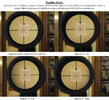Parallax ONLY cares about the objective diameter and the relative distances for the field distance vs. the parallax focused distance.
Maximum Parallax Error potential in millimeters = 1/2 ((Objective diameter in millimeters) * absolute value of (Field distance - Parallax focused distance)) / (parallax focused distance)
**Note "absolute value" means the non-negative value, so if you have a 50mm focused scope and you're shooting at 25yrds, that value would be negative, but then you'd have a negative value for the distance, so it's simply 25, instead of -25
What this means:
Let's start with a 40mm rimfire scope focused at 50yrds, shot at 100yrds. 1/2 * 40 * abs(100-50) / 50 = 20mm of maximum potential error.
Comparatively, a 40mm centerfire scope focused at 100yrds, shot at 50yrds. 1/2 *40 * abs(50-100) / 100 = 10mm of maximum potential error.
Because we divide by the focus distance, as long as the difference between firing distance and focus distance is smaller than the focus distance, we end up with a factor less than 1 - so that favors that we get LESS parallax error with longer parallax settings than we would get by shooting the same offset in distance with a scope with a shorter fixed parallax.
**Also note - this formula dictates the MAXIMUM POTENTIAL parallax error. Meaning you'd have to have your head SO FAR OUT OF POSITION that you're obviously seeing shadowing and flashing in the FoV to warn you that you're out of line from the optic. AND because errors are not additive, we know we'd only ever expect to experience significantly less than that maximum - in general, I've seen most errors in ballistics tend to shrink by 75-85% in application, only contributing 1/8-1/4 of their gross opportunity to the actual results.



